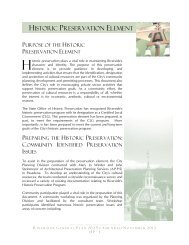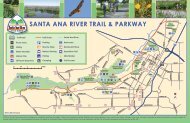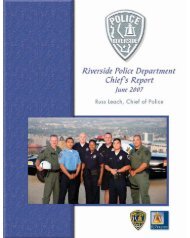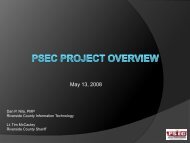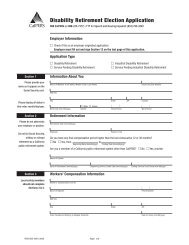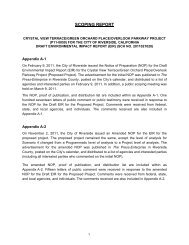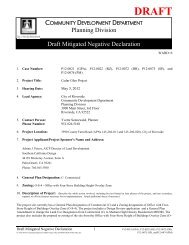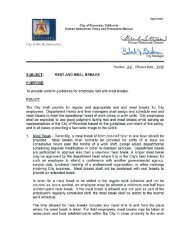Northside - City of Riverside
Northside - City of Riverside
Northside - City of Riverside
Create successful ePaper yourself
Turn your PDF publications into a flip-book with our unique Google optimized e-Paper software.
was believed to have constructed the residence after his arrival in <strong>Riverside</strong> in 1902.<br />
Although the Colonial Revival style, <strong>of</strong> which the Classic Box, or Foursquare, is a<br />
subtype, is commonly seen in <strong>Riverside</strong> in the first years <strong>of</strong> the 20 th century,<br />
McAlester sets the period for the style from 1880-1955 (McAlester 2000:321). Though<br />
rare in <strong>Riverside</strong>, the earliest examples would have undoubtedly been influenced by<br />
neighboring Victorian Era predecessors as the form <strong>of</strong> late examples throughout the<br />
<strong>City</strong> are shaped by the sprawling, post-WWII Ranch style.<br />
Assessor’s Records support this evaluation <strong>of</strong> the blend <strong>of</strong> architectural styles found<br />
in this early Foursquare as well as the current owners’ (Scott and Joanne Simpson)<br />
discovery <strong>of</strong> 1893 newspaper shreds found in the attic as insulation. C.G. Atwood is<br />
listed as the owner <strong>of</strong> the property in 1892, and no figures are listed for building<br />
improvements or trees. The following year, an improvement is assessed at $1200<br />
with the notation, “House + S,” and $1,180 is listed for trees, which are noted to be a<br />
mixture <strong>of</strong> buds and seeds (Assessor’s Records 1892-1895:Bk. 2, Pg. 3). Clearly, the<br />
home and grove were established by 1893, and the residence is an example <strong>of</strong> an<br />
early Classic Box, or Foursquare, one <strong>of</strong> the nine principal subtypes <strong>of</strong> the Colonial<br />
Revival style built during <strong>Riverside</strong>’s grove-inspired Victorian Era as it moved into<br />
the Eclectic Period.<br />
The C.G. Atwood House has been associated with several families <strong>of</strong> long-term<br />
occupancy. Historical accounts suggest that William H. and Mary Wilson, longbelieved<br />
to be the home’s first owners and occupants, had arrived in <strong>Riverside</strong> in<br />
1902, and Assessor’s records indicate that he either acquired the reduced property <strong>of</strong><br />
4.5 acres by 1905 (Assessor’s Records 1899-1907:Bk. 2, Pg. 3; Hall 2003:41). The<br />
Wilsons established a small dairy on the property, maintained a citrus grove, and<br />
raised livestock. Arthur D. Paxton, employed with the Southern California Gas<br />
Company, purchased the home in 1920, and the property’s use shifted more toward<br />
dairy production than citrus. Though the exterior staircase on the veranda was<br />
extant and rooms in the home were already being rented out when the Paxtons<br />
moved in, according to the Paxton daughters, Harriet and Mary Helen, many<br />
alterations and additions were made to the home during the Paxton period such as<br />
the addition <strong>of</strong> the kitchen and enclosed sleeping porches and alterations and<br />
additions to the rear <strong>of</strong> the home. The Paxtons continued to rent out the entire<br />
second floor <strong>of</strong> the residence until they sold the property in 1956 to the Bumsteads<br />
(Mermilliod 2005a). By this time, the area around it had been subdivided as part <strong>of</strong><br />
the Oak Manor No. 3 Tract (1954), one <strong>of</strong> three subdivisions in the early 1950s that<br />
added the Audubon Place and Hiawatha Place cul-de-sacs to the Southeast<br />
Quadrant and the original parcel had been reduced to .84 acres (M.B. 27/33). The<br />
Bumsteads (1956-1978) and later the Osborns (1978-1997) are credited with<br />
preserving and restoring much <strong>of</strong> the old house and converting the interior <strong>of</strong> the<br />
home back into a single-family residence (Hall 2003:43). The Simpsons are<br />
66



